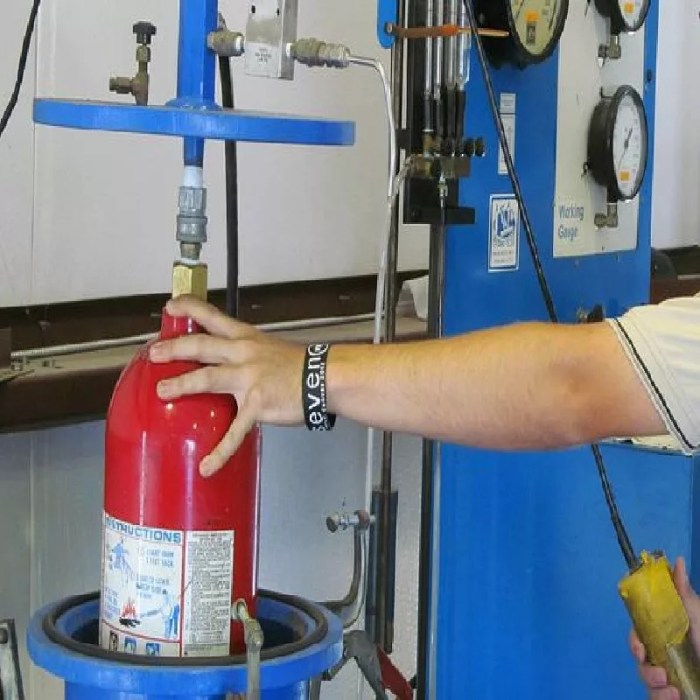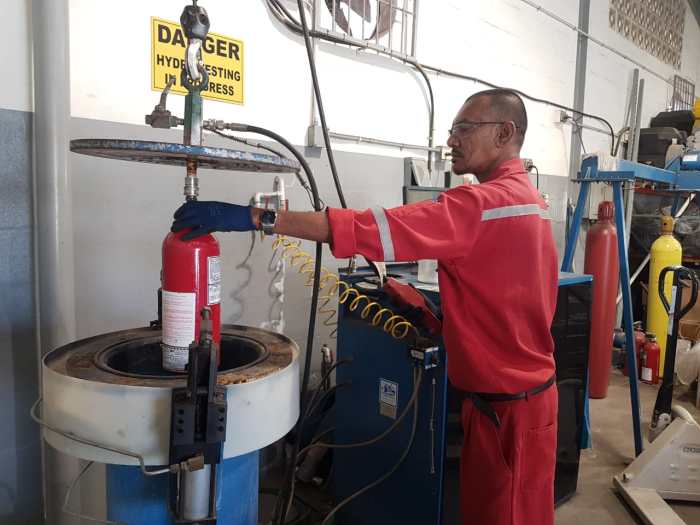Hydrostatic testing of fire extinguishers plays a crucial role in maintaining the safety and reliability of these essential fire protection devices. This process involves subjecting fire extinguishers to high water pressure to assess their integrity and detect any potential defects.
By understanding the purpose, procedures, and best practices associated with hydrostatic testing, organizations can effectively ensure the proper functioning of their fire extinguishers and comply with regulatory requirements.
This comprehensive guide delves into the intricacies of hydrostatic testing, providing a clear understanding of its significance, the equipment and preparation involved, the step-by-step testing procedure, and the criteria for evaluating test results. Additionally, it highlights the importance of record keeping, best practices, and regular maintenance to ensure the continued effectiveness of fire extinguishers.
Hydrostatic Testing: Overview

Hydrostatic testing is a critical procedure for ensuring the safety and reliability of fire extinguishers. It involves subjecting the extinguisher to high water pressure to test its integrity and detect any potential leaks or defects. This testing is mandated by regulatory bodies and industry standards to guarantee the effectiveness and safety of fire extinguishers.
Equipment and Preparation, Hydrostatic testing of fire extinguishers
Hydrostatic testing requires specialized equipment, including a pressure gauge, pump, and water tank. The extinguisher must be properly prepared before testing, which involves draining any residual extinguishing agent, cleaning the extinguisher, and inspecting it for any visible damage or corrosion.
Testing Procedure
The hydrostatic testing procedure involves pressurizing the extinguisher with water to a predetermined level, typically 1.5 to 2 times the extinguisher’s rated working pressure. The extinguisher is held under pressure for a specified duration, usually 30 to 60 seconds, while it is closely inspected for any leaks or signs of distress.
The pressure is then gradually released, and the extinguisher is thoroughly inspected again.
During testing, safety precautions must be strictly followed, including wearing appropriate protective gear, using a shielded area, and following established safety protocols.
Inspection and Evaluation
The results of hydrostatic testing are evaluated against established criteria, including the maximum allowable pressure and the absence of leaks. If the extinguisher passes the test, it is considered safe for continued use. If it fails, it may require repairs or disposal, depending on the severity of the failure.
Record Keeping and Documentation
Accurate records of hydrostatic testing results are essential for maintaining the safety and traceability of fire extinguishers. These records should include the date of testing, the test pressure, the results of the inspection, and any actions taken as a result of the test.
Inspection tags or digital reports are common methods for documenting test results.
Best Practices and Maintenance
Regular hydrostatic testing is recommended to ensure the reliability of fire extinguishers. The frequency of testing varies depending on the type of extinguisher, the environment in which it is used, and regulatory requirements. Proper storage conditions, including protection from extreme temperatures and moisture, are crucial for maintaining the integrity of fire extinguishers.
In addition to hydrostatic testing, regular maintenance and inspection of fire extinguishers are essential for their effectiveness. This includes visual inspections, cleaning, and recharging as needed. Proper maintenance helps identify and address potential issues before they become significant problems, ensuring the readiness and effectiveness of fire extinguishers in case of an emergency.
Key Questions Answered: Hydrostatic Testing Of Fire Extinguishers
What is the purpose of hydrostatic testing?
Hydrostatic testing is performed to assess the structural integrity of fire extinguishers and detect any potential leaks or defects. It ensures that the extinguisher can withstand the internal pressure generated during discharge and remain operational in an emergency.
How often should fire extinguishers be hydrostatically tested?
The frequency of hydrostatic testing varies depending on the type of extinguisher and the regulations in different jurisdictions. Typically, portable fire extinguishers are tested every 5-10 years, while larger fixed fire extinguishers may require testing every 1-2 years.
Who should perform hydrostatic testing?
Hydrostatic testing should only be performed by qualified and trained personnel who are familiar with the specific requirements and safety protocols associated with this process. It is recommended to engage the services of a certified fire extinguisher technician or a reputable fire protection company.

